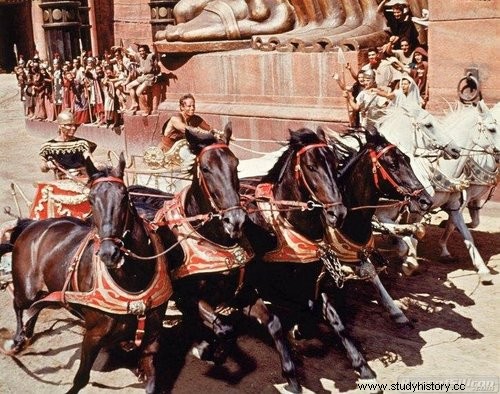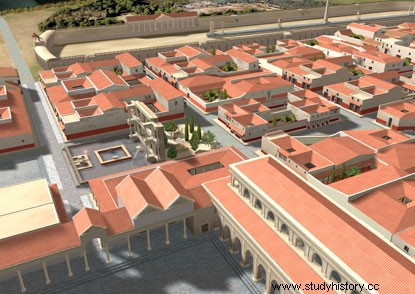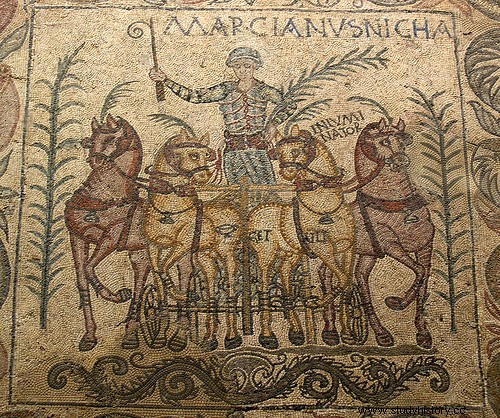What hobby is more popular and visceral than sitting in the stands of a packed sports arena on a warm spring afternoon? Crowds filling the stands, dressed in the colors of their idols, people distributing drinks and fripperies among the respectable, bets on money or pride on who will win and who will not, exalted spirits and, down there, great heroes admired and desired by all...
Obviously, you will assume that I am not talking about a football match, a social heritage from other times, but about the Circus , the Ludus Maximus , the most popular attraction of attractions in the Roman world.
As it could not be otherwise, the Circus is the maximum expression of the ancient Greek hippodrome, but much larger in its dimensions and in the business and hobby that came to arouse One of the great erroneous topics about the Roman Circus is to associate it with the fight of beasts and bloody gladiator shows. The Circus was a purely sports venue where chariot races were held, immortalized for film history by Charlton Heston (Ben Hur ) and Stephen Boyd (Messala ) in that evocative scene…

Ben-Hur
The floor of the Circus was rectangular with wide and round ends to favor the opening in the turning of the cars. In a general view it would resemble a current oval stadium, but much more elongated. The main track, called arena as in amphitheatres, it was split in two by a small wall, the spina , which acted as a separator and could be very simple or full of statuary, obelisks or ornaments in the largest enclosures. At each end of the spina was the goal , a conical pillar. In the center of that separating wall was the septem oba, the manual scoreboard generally represented with seven fish or dolphins that leaned each time the runners turned.
The Circus was one of the symbols of splendor of Rome . Not all cities had one, only those whose citizens had enough economic power to pay for its construction back in the 1st century AD. The bare ruins of some of them have survived to this day, such as the cases of Emérita Augusta, Segobriga or Toletum , but most of them are today under the urban framework as in Saguntum, Valentia or Calagurris . From the former we know its exact dimensions; in the case of the Merida stadium, it was 400m long by 30m wide, accommodating nearly 30,000 spectators. More modest circuses like the one in Valentia they had a capacity close to 3,500 souls, even so important figures for the scarce demographics of the time.

Forum and Circus of Valentia
It will serve as a comparison that the Circus Maximus in Rome After César's reform, it had a 600m track by 200m wide and could accommodate nearly 150,000 spectators… Up to twelve chariots could run and turn in parallel! How lavish would that enclosure be for Augustus to place an Egyptian obelisk on its spine and with the dismantling of its blocks in the 16th century the Basilica of Saint Peter was built... Venerable stones that have not stopped seeing spectacles since they were chiselled.

Circus Maximus Rome
But the true protagonists of those events were not the duumvirs who paid for the show or the emperors who paid for such great works, but those who risked their lives on the chariots to the delight of commoners and patricians:the charioteers . Many of them were slaves and if their careers culminated in success they could buy their freedom, although freedmen have also been known to compete in all arenas of the Empire. Not only did they have ardent male fans, but many matrons required the favors of great champions. Elite athletes have always been the target of many fantasies...

Charioteer
Those risky charioteers who risked their lives in each race drove several types of chariots:bigas (two horses), trigas (three) or chariots (four), the latter being the ones that we retain in our retinas when we imagine the races, perhaps also as an influence of the aforementioned Ben-Hur. Perhaps the most famous charioteer in the entire Empire was Caius Apuleius Diocles , a Hispanic from Lusitanian who came to run for twenty-four years, a great achievement in such a dangerous profession. He participated in 4,257 races of which won 1,462 , victories that brought him an indecent amount of 35 million sesterces . He passed away as a great potentate at the age of forty-two in his villa at Praeneste (Italy)… The custom of paying drivers well is not an invention of Formula 1. Diocles He was a true “Fernando Alonso ” of the reins.
Collaboration of Gabriel Castelló.
